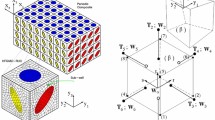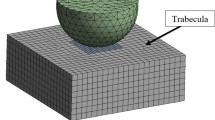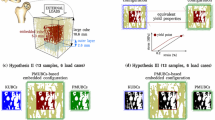Abstract
Two- and three-dimensional structural models of the vertebral body have been used to estimate the mechanical importance of parameters that are difficult to quantify experimentally such as lattice disorder, trabecular thickness, trabecular spacing, connectivity, and fabric. Many of the models that investigate structure–function relationships of the vertebral body focus only on the trabecular architecture and neglect solid–fluid interactions. We developed a cellular solid model composed of two idealized unit cell geometries to investigate the continuum and micro-structural properties of human vertebral cancellous bone in a mathematically tractable model. Using existing histomorphological data we developed structure–function relationships for the mechanical properties of the solid phase, estimated the micro-structural strains, and predicted the fluid flow characteristics. We found that the micro-structural strains may be 1.7 to 2.2 times higher than the continuum level strains between the ages of 40 and 80. In addition, the predicted permeability agrees well with the experimental data.






Similar content being viewed by others
References
Arramon YP, Nauman EA (2001) The intrinsic permeability of cancellous bone. In: Cowin SC (ed) Bone mechanics handbook. CRC Press, Boca Raton, pp 25.1–25.17
Beaudoin AJ, Mihalko WM, Krause WR (1991) Finite element modelling of polymethylmethacrylate flow through cancellous bone. J Biomech 24:127–36
Bryant JD, David T, Gaskell PH, King S, Lond G (1989) Rheology of bovine bone marrow. Proc Inst Mech Eng [H] 203:71–75
Chrischilles E, Shireman T, Wallace R (1994) Costs and health effects of osteoporotic fractures. Bone 15:377–386
Christensen RM (2000) Mechanics of cellular and other low-density materials. Int J Solids Struct 37:93–104
Drummond JE, Tahir MI (1984) Laminar viscous flow through regular arrays of parallel solid cylinders. Int J Multiphase Flow 10:515–540
Ebbesen EN, Thomsen JS, Beck-Nielsen H, Nepper-Rasmussen HJ, Mosekilde L (1999) Age- and gender-related differences in vertebral bone mass, density, and strength. J Bone Miner Res 14:1394–1403
Fourie JG, Du Plessis JP (2002) Pressure drop modelling in cellular metallic foams. Chem Eng Sci 57:2781–2789
Gibson LJ (1985) The mechanical behaviour of cancellous bone. J Biomech 18:317–328
Gibson LJ, Ashby MF (1997) Cellular solids: structures and properties. Pergamon Press, Oxford
Guo XE, Kim CH (2002) Mechanical consequence of trabecular bone loss and its treatment: a three-dimensional model simulation. Bone 30:404–411
Hildebrand T, Laib A, Muller R, Dequeker J, Ruegsegger P (1999) Direct three-dimensional morphometric analysis of human cancellous bone: microstructural data from spine, femur, iliac crest, and calcaneus. J Bone Miner Res 14:1167–1174
Hui PW, Leung PC, Sher A (1996) Fluid conductance of cancellous bone graft as a predictor for graft–host interface healing. J Biomech 29:123–132
Jackson GW, James DF (1982) The hydrodynamic resistance of hyaluronic acid and its contribution to tissue permeability. Biorheology 19:317–330
Jackson GW, James DF (1986) The permeability of fibrous porous media. Can J Chem Eng 64:364–374
Jensen KS, Mosekilde L (1990) A model of vertebral trabecular bone architecture and its mechanical properties. Bone 11:417–423
Keaveny TM, Hayes WC (1993) A 20-year perspective on the mechanical properties of trabecular bone. J Biomech Eng 115:534–542
Kim HS, Al-Hassani ST (2002) A morphological model of vertebral trabecular bone. J Biomech 35:1101–1114
Kleerekoper M, Villanueva AR, Stanciu J, Rao DS, Parfitt AM (1985) The role of three-dimensional trabecular microstructure in the pathogenesis of vertebral compression fractures. Calcif Tissue Int 37:594–597
Kopperdahl DL, Keaveny TM (1998) Yield strain behavior of trabecular bone. J Biomech 31:601–608
Liebschner MA, Rosenberg WS, Keaveny TM (2001) Effects of bone cement volume and distribution on vertebral stiffness after vertebroplasty. Spine 26:1547–1554
Melton LJ 3rd, Kan SH, Frye MA, Wahner HW, O'Fallon WM, Riggs BL (1989) Epidemiology of vertebral fractures in women. Am J Epidemiol 129:1000–1011
Mosekilde L (1988) Age-related changes in vertebral trabecular bone architecture—assessed by a new method. Bone 9:247–250
Mosekilde L (1990) Sex differences in age-related changes in vertebral body size, density and biomechanical competence in normal individuals. Bone 11:67–73
Mosekilde L (1993) Vertebral structure and strength in vivo and in vitro. Calcif Tissue Int 53:S121–S125; discussion S125–S126
Mosekilde L, Danielsen CC (1987) Biomechanical competence of vertebral trabecular bone in relation to ash density and age in normal individuals. Bone 8:79–85
Nauman EA, Fong KE, Keaveny TM (1999) Dependence of intertrabecular permeability on flow direction and anatomic site. Ann Biomed Eng 27:517–524
Niebur GL, Feldstein MJ, Yuen JC, Chen TJ, Keaveny TM (2000) High-resolution finite element models with tissue strength asymmetry accurately predict failure of trabecular bone. J Biomech 33:1575–1583
Obrant KJ, Bengner U, Johnell O, Nilsson BE, Sernbo I (1989) Increasing age-adjusted risk of fragility fractures: a sign of increasing osteoporosis in successive generations? Calcif Tissue Int 44:157–167
Ochia RS, Ching RP (2002) Hydraulic resistance and permeability in human lumbar vertebral bodies: internal pressure measurements during burst fracture formation in human lumbar vertebrae. J Biomech Eng 124:533–537
Parfitt AM (1984) Age-related structural changes in trabecular and cortical bone: cellular mechanisms and biomechanical consequences. Calcif Tissue Int 36:S123–S128
Pothuaud L, Van Rietbergen B, Mosekilde L, Beuf O, Levitz P, Benhamou CL, Majumdar S (2002) Combination of topological parameters and bone volume fraction better predicts the mechanical properties of trabecular bone. J Biomech 35:1091–1099
Riggs BL, Melton LJ 3rd (1995) The worldwide problem of osteoporosis: insights afforded by epidemiology. Bone 17:505S–511S
Scheidegger AE (1974) The physics of flow through porous media. University of Toronto Press, Toronto
Silva MJ, Gibson LJ (1997) Modeling the mechanical behavior of vertebral trabecular bone: effects of age-related changes in microstructure. Bone 21:191–199
Skartsis L, Kardos JL, Khomami B (1992) Resin flow through fiber beds during composite manufacturing processes. Part I: Review of Newtonian flow through fiber beds. Polymer Eng Sci 32:221–230
Snyder BD, Piazza S, Edwards WT, Hayes WC (1993) Role of trabecular morphology in the etiology of age-related vertebral fractures. Calcif Tissue Int 53: S14–S22
Steenkamer DA, McKnight SH, Wilkins DJ, Karbhari VM (1995) Experimental characterization of permeability and fibre wetting for liquid moulding. J Mater Sci 30:3201–3215
Thomsen JS, Ebbesen EN, Mosekilde L (2002) Zone-dependent changes in human vertebral trabecular bone: clinical implications. Bone 30:664–669
Turner CH, Rho J, Takano Y, Tsui TY, Pharr GM (1999) The elastic properties of trabecular and cortical bone tissues are similar: results from two microscopic measurement techniques. J Biomech 32:437–441
Vajjhala S, Kraynik AM, Gibson LJ (2000) A cellular solid model for modulus reduction due to resorption of trabeculae in bone. J Biomech Eng 122:511–515
Yeh OC, Keaveny TM (1999) Biomechanical effects of intraspecimen variations in trabecular architecture: a three-dimensional finite element study. Bone 25:223–228
Yerby SA, Bay BK, Toh E, McLain RF, Drews MJ (1998) The effect of boundary conditions on experimentally measured trabecular strain in the thoracic spine. J Biomech 31:891–897
Acknowledgements
Support for this work was provided by a Louisiana Board of Regents Fellowship, the Whitaker Foundation, and the National Science Foundation (BES-9983931). The authors would like to thank Tony Keaveny and Sean Haddock for rendering the three-dimensional architecture of vertebral cancellous bone and the following researchers for fruitful discussions concerning various aspects of this model: Yves Arramon, Glen Livesay, Oscar Yeh, Glen Niebur, and Tony Keaveny. We are also grateful to Bill Newman for his insights and assistance.
Author information
Authors and Affiliations
Corresponding author
Rights and permissions
About this article
Cite this article
Sander, E.A., Shimko, D.A., Dee, K.C. et al. Examination of continuum and micro-structural properties of human vertebral cancellous bone using combined cellular solid models. Biomech Model Mechanobiol 2, 97–107 (2003). https://doi.org/10.1007/s10237-003-0031-6
Received:
Accepted:
Published:
Issue Date:
DOI: https://doi.org/10.1007/s10237-003-0031-6




